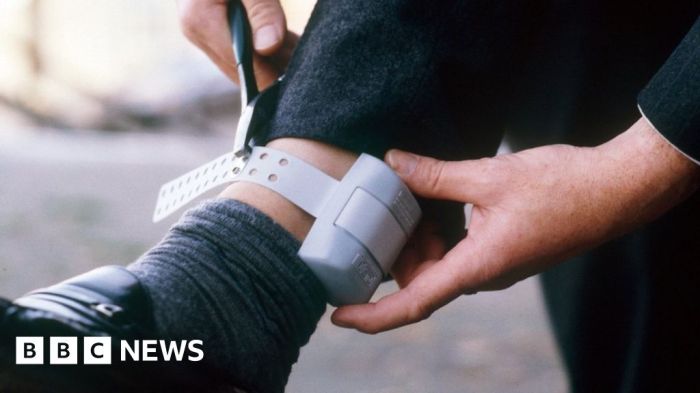Criminals in uk tracked gps tags – Criminals in UK tracked by GPS tags: It’s a modern twist on an age-old problem – keeping tabs on those who break the law. But how does it actually work? From the legal frameworks underpinning this surveillance to the tech behind the trackers and the ethical dilemmas it raises, we delve into the world of GPS tagging in the UK. This isn’t just about tracking; it’s about rehabilitation, societal safety, and the ever-evolving relationship between technology and justice.
This deep dive explores the intricacies of the UK’s system, comparing it to other European nations, and analyzing the effectiveness of GPS tracking in reducing crime. We’ll uncover the technological specifics, examining the accuracy and limitations of the devices, and the processes involved in monitoring offenders. We also look at the societal impact, considering both the benefits and potential drawbacks, including privacy concerns.
Technological Aspects of GPS Tracking Devices
The use of GPS tracking in the UK criminal justice system represents a significant technological advancement in monitoring and managing offenders. These devices, varying in sophistication and capabilities, play a crucial role in public safety and rehabilitation efforts. Understanding the technology behind these trackers is vital to assessing their effectiveness and limitations.
GPS tracking devices used on UK criminals range from simple ankle bracelets to more advanced, multi-sensor systems. The choice of device depends on the individual’s risk level and the specific conditions of their release. This technology is constantly evolving, with new features and capabilities being developed to enhance accuracy and improve security.
Types of GPS Tracking Devices
Several types of GPS tracking devices are employed within the UK’s criminal justice system. These devices differ in their size, functionality, and the level of monitoring they provide. Basic models primarily track location, while more advanced versions incorporate additional sensors to detect tamper attempts and monitor behavior. For instance, some devices might include alcohol sensors to detect consumption, or even heart rate monitors to track physiological responses.
Accuracy, Reliability, and Limitations of GPS Tracking Technologies
The accuracy of GPS tracking is generally high, typically within a margin of a few meters. However, several factors can affect reliability. Signal interference from buildings, dense foliage, or atmospheric conditions can lead to inaccuracies or signal loss. Furthermore, deliberate attempts to jam or disable the signal are a significant concern. The limitations extend beyond purely technical issues; the effectiveness of GPS tracking depends heavily on the quality of the monitoring system and the responsiveness of authorities to alerts. For example, a delayed response to a breach of curfew could render the technology less effective. Furthermore, the technology’s reliance on satellite signals means that it is less effective in areas with poor satellite coverage, such as underground environments or remote areas.
Data Integrity and Security Measures
Maintaining the integrity and security of data collected by GPS trackers is paramount. This involves multiple layers of security, from encryption of data transmitted from the device to robust data storage and access control protocols. Data is often encrypted both in transit and at rest, minimizing the risk of unauthorized access or modification. Strict protocols are in place to control who can access the data and for what purposes. Regular audits and system checks are performed to identify and address any vulnerabilities. For instance, data might be stored on secure servers with access limited to authorized personnel only, using multi-factor authentication. This multi-layered approach aims to ensure the reliability and trustworthiness of the data used in managing offenders.
Data Flow from GPS Tracker to Monitoring Authorities
The following flowchart illustrates the typical data flow:
[Imagine a flowchart here. The flowchart would begin with the GPS tracker on the offender’s person. An arrow would lead to a cellular or satellite network. Another arrow would lead to a data processing center, where the data is encrypted and processed. A final arrow would lead to the monitoring authorities’ system, displaying the offender’s location and other relevant data. The flowchart would clearly show the data encryption at various stages and the access control measures in place.]Implementation and Monitoring Procedures: Criminals In Uk Tracked Gps Tags
GPS tracking of offenders in the UK is a complex process, involving careful consideration of individual circumstances and legal frameworks. The implementation and monitoring of these devices are crucial for ensuring public safety and upholding the conditions of release. The entire process, from initial court order to device removal, is tightly regulated and involves multiple agencies working in coordination.
The fitting of a GPS tag typically involves a pre-arranged appointment with a designated fitting team. This team might include probation officers, police personnel, or private contractors depending on the individual case and the specific requirements of the court order. The device, usually a small, tamper-proof unit, is attached to the offender’s ankle or wrist using a secure strap. The process itself is relatively quick, often taking less than an hour, and aims to be as minimally intrusive as possible. Detailed instructions regarding the device’s operation and the conditions of its use are provided to the offender.
Device Monitoring and Breach Detection
Monitoring of the GPS data occurs remotely, using sophisticated software systems. These systems continuously track the tag’s location, recording its position at regular intervals. The data is usually transmitted via cellular networks, providing near real-time updates to the monitoring team. The system is programmed to alert authorities if the offender enters a pre-defined exclusion zone, fails to remain within a designated curfew area, or if the device is tampered with or removed. Advanced algorithms are employed to filter out potential inaccuracies in the GPS signal, ensuring that alerts are triggered only in cases of genuine breaches. For instance, a temporary signal loss due to poor network coverage would not trigger an immediate response, but a prolonged absence from a designated area would be flagged.
Response Protocols for Breaches
When a breach of the tracking conditions is detected, a multi-stage response protocol is activated. The initial response often involves a notification to the monitoring team, who will then assess the severity of the breach. Minor anomalies, such as temporary signal disruptions, are usually investigated further before any action is taken. However, more serious breaches, such as entering a prohibited area or removing the tag, will trigger an immediate response, often involving the police. The police will then investigate the circumstances of the breach and decide on appropriate action, which could range from a warning to arrest and re-incarceration, depending on the seriousness of the offense and the offender’s history. For example, a single, brief incursion into a restricted area might result in a caution, while repeated violations or more serious breaches could lead to immediate arrest and a return to prison.
Step-by-Step Process: Court Order to Device Removal
- Court Order: A court issues an order mandating the use of a GPS tracking device as part of the offender’s sentence or release conditions. The order will specify the duration of monitoring, any exclusion zones, and curfew restrictions.
- Device Fitting: The offender is notified of the appointment and attends for the device to be fitted. They receive instructions on its operation and the consequences of breaching the conditions.
- Monitoring Period: The offender is monitored continuously throughout the period specified by the court order. Data is transmitted to the monitoring centre and reviewed regularly.
- Breach Response (if applicable): If a breach occurs, the response protocol is activated, leading to investigation and potential action by the authorities.
- Device Removal: Once the monitoring period is complete and all conditions have been met, the device is professionally removed by the designated fitting team. A confirmation of removal is recorded.
Impact on Criminals and Society
GPS tracking of criminals in the UK presents a complex tapestry of societal impacts, weaving together threads of improved public safety, enhanced rehabilitation prospects, and significant privacy concerns. The technology’s effectiveness hinges on its careful implementation and ongoing evaluation, balancing the need for accountability with fundamental rights.
GPS tracking’s impact on both criminals and society is multifaceted and far-reaching. While it offers the potential for improved public safety and enhanced rehabilitation, it also raises serious ethical and practical questions regarding individual liberties and the potential for misuse. The effectiveness of this technology in reducing recidivism, compared to other methods, remains a subject of ongoing debate and research.
Rehabilitation and Reintegration of Offenders
The potential for GPS tracking to aid in offender rehabilitation and reintegration is a key area of discussion. By allowing for monitored community reintegration, offenders can gradually rebuild their lives while still being subject to supervision. This structured approach can provide a supportive framework, helping them access necessary resources like employment services, substance abuse treatment, and mental health support. However, the constant surveillance inherent in GPS tracking could also create a sense of stigma and hinder the development of trusting relationships crucial for successful reintegration. The success of this approach depends heavily on the support systems available to the offender and the overall approach taken by the supervising authorities. For example, a program combining GPS tracking with intensive case management has shown more promising results than GPS tracking alone in some studies.
Privacy Concerns Associated with GPS Tracking
Widespread use of GPS tracking technology raises significant privacy concerns. The constant monitoring of an individual’s movements raises questions about the balance between public safety and individual liberty. Data collected by GPS trackers could be misused or accessed without proper authorization, leading to potential violations of personal privacy. The potential for data breaches and the long-term storage of location data are significant risks. Furthermore, the psychological impact of constant surveillance on individuals, even those who have served their sentences, should not be underestimated. The lack of transparency regarding data usage and storage policies also contributes to the overall concern.
Effectiveness of GPS Tracking in Reducing Recidivism
The effectiveness of GPS tracking in reducing recidivism rates compared to other offender management methods is a subject of ongoing research. While some studies suggest a positive correlation between GPS monitoring and reduced reoffending, other research has shown less conclusive results. The effectiveness often depends on various factors, including the type of crime, the offender’s background, and the support systems in place. For example, GPS tracking might be more effective for certain types of offenders, such as those convicted of domestic violence, compared to others. A comprehensive comparison requires a thorough analysis considering the specific circumstances of each case and a nuanced understanding of the different methods employed. Other methods, such as intensive probation supervision or community-based programs, may achieve comparable or even better results in certain contexts.
The use of GPS tracking for criminals presents a range of potential benefits and drawbacks. It’s crucial to weigh these carefully to ensure responsible and ethical implementation.
- Benefits: Increased public safety through enhanced monitoring; improved rehabilitation and reintegration through structured support; potential reduction in recidivism rates; efficient allocation of resources for law enforcement; easier monitoring of high-risk offenders.
- Drawbacks: Potential for privacy violations; psychological impact of constant surveillance; risk of data breaches and misuse; potential for increased stigmatization of offenders; high cost of implementation and maintenance; potential for false positives and technical malfunctions.
The use of GPS tags on criminals in the UK is a complex issue, balancing the need for public safety with individual rights. While the technology offers a powerful tool for monitoring and potentially reducing recidivism, it’s crucial to address the ethical considerations and ensure responsible implementation. As technology advances, so too will the capabilities and implications of this system, demanding ongoing scrutiny and adaptation to ensure fairness and effectiveness.
 Tech Nest Online Berita Teknologi Terbaru
Tech Nest Online Berita Teknologi Terbaru

